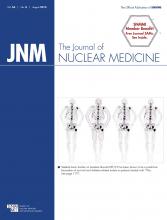TO THE EDITOR: We read with interest the article by Riedl and colleagues (1), who retrospectively investigated the yield from 18F-FDG PET/CT staging in 134 breast cancer patients younger than 40 y. PET/CT allowed detection of unsuspected extraaxillary lymph nodes in 11% of patients and distant metastases in 15% (1). This important report adds to other recent studies emphasizing the role of PET/CT staging in patients with clinical stage II or III breast cancer (2–6). The study by Riedl et al. focused on patients younger than 40 y, a population at higher risk for cancer mortality (7). However, their results should not be taken as an indication that PET/CT should be restricted to this age group. Indeed, the study did not compare the yield of PET/CT in young women to that in patients older than 40 y, who represent most breast cancer patients. Interestingly, retrospective findings from Riedl and colleagues in women younger than 40 y agree with our findings in a prospective evaluation of 254 patients unselected for age (4). The yield according to initial clinical stage in the study by Riedl et al. was quite similar to ours, with the detection of distant metastases in 50% of stage IIIC patients (vs. 47% in our study), in 50% of stage IIIB (vs. 36.5%), in 31% of stage IIIA (vs. 17.5%), in 17% of stage IIB (vs. 10.7%), and in 5% of stage IIA (vs. 2.3%). As also observed by Segaert et al. (2), these results show that 18F-FDG PET/CT has a substantial yield in breast cancer patients with clinical stage IIB or higher.
It is well known that younger patients with breast cancer have a poorer prognosis (7). On 18F-FDG PET/CT imaging, the SUVs of the primary breast cancer are higher in premenopausal women (8). One explanation for the poorer outcome in young women is the higher incidence of biologically unfavorable factors such as high-grade and estrogen receptor–negative tumors (7). However, Riedl and colleagues found that the rates of distant involvement did not differ according to tumor grade or phenotype. This is in agreement with our findings in 254 patients unselected for age (4). We observed that triple-negative breast cancers were more 18F-FDG–avid, with a higher proportion of extraskeletal metastases compared with bone metastases. We also found that triple-negative breast cancer patients had poorer survival. However, the overall rate of distant metastases on baseline 18F-FDG PET/CT was similar to that in other phenotypes (HER2+ and ER+/HER2−) (4).
In conclusion, there is mounting evidence of a high yield offered by 18F-FDG PET/CT staging in patients with clinical stage III or IIB breast cancer.
Footnotes
Published online Jun. 4, 2015.
- © 2015 by the Society of Nuclear Medicine and Molecular Imaging, Inc.







